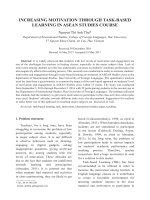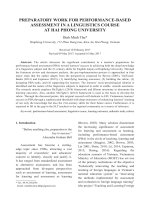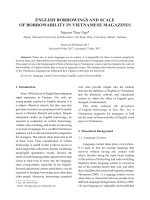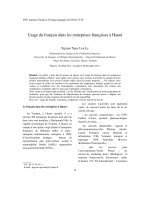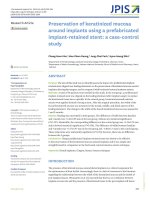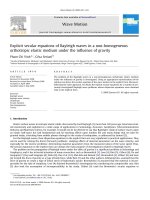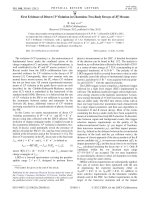DSpace at VNU: Methanogenesis Facilitated by Geobiochemical Iron Cycle in a Novel Syntrophic Methanogenic Microbial Community
Bạn đang xem bản rút gọn của tài liệu. Xem và tải ngay bản đầy đủ của tài liệu tại đây (1.12 MB, 7 trang )
Article
pubs.acs.org/est
Methanogenesis Facilitated by Geobiochemical Iron Cycle in a Novel
Syntrophic Methanogenic Microbial Community
Shenghua Jiang,†,‡ Sunhwa Park,† Younggun Yoon,† Ji-Hoon Lee,§ Wei-Min Wu,‡ Nguyen Phuoc Dan,∥
Michael J. Sadowsky,⊥ and Hor-Gil Hur*,†
†
School of Environmental Science and Engineering, Gwangju Institute of Science and Technology, Gwangju 500-712, Republic of
Korea
§
Korea Institute of Geoscience and Mineral Resources, Daejeon 305-350, Republic of Korea
‡
Department of Civil and Environmental Engineering, Stanford University, Stanford, California 94305, United States
∥
Faculty of Environment, Ho Chi Minh City University of Technology, Ho Chi Minh City, Vietnam
⊥
BioTechnology Institute and Department of Soil, Water, and Climate, University of Minnesota, St. Paul, Minnesota 55108, United
States
S Supporting Information
*
ABSTRACT: Production and emission of methane have been
increasing concerns due to its significant effect on global climate
change and the carbon cycle. Here we report facilitated methane
production from acetate by a novel community of methanogens and
acetate oxidizing bacteria in the presence of poorly crystalline
akaganeite slurry. Comparative analyses showed that methanogenesis
was significantly enhanced by added akaganeite and acetate was mostly
stoichiometrically converted to methane. Electrons produced from
anaerobic acetate oxidation are transferred to akaganeite nanorods that
likely prompt the transformation into goethite nanofibers through a
series of biogeochemical processes of soluble Fe(II) readsorption and
Fe(III) reprecipitation. The methanogenic archaea likely harness the
biotransformation of akaganeite to goethite by the Fe(III)−Fe(II)
cycle to facilitate production of methane. These results provide new insights into biogeochemistry of iron minerals and
methanogenesis in the environment, as well as the development of sustainable methods for microbial methane production.
■
INTRODUCTION
Biological methanogenesis widely occurs in natural environments including soils, water, deep sea and digestive systems of
some animals and plays an important role in global carbon
cycling.1−5 Methane producing microorganisms, mainly methanogenic archaea, which obtain energy for growth by
converting a limited number of substrates to methane, are
common in anaerobic environments where organic matter
undergoes decomposition.6,7 The main precursor for methane
production by methanogens is often acetate, which is one of the
most abundant products from anaerobic digestion of organic
matter via bacterial catabolism.6,8,9 Two mechanisms for
methane generation from acetate by methanogens have been
known, such as an aceticlastic reaction10 and a two-step process
in which acetate is first oxidized to H2 and CO2, followed by
their subsequent conversion to methane by methanogens.9,11 In
the latter process, although some methanogens, such as
Methanosarcinaceae, are capable of independently oxidizing
acetate by themselves,11 various syntrophic bacteria are also
involved in multistep processes such as acetogenic fermentation, syntrophic acetate oxidation, and hydrogenotrophic
methane production.12
© 2013 American Chemical Society
In the syntrophic methanogenic system, acetate-oxidation is
thermodynamically inferior to the aceticlastic pathway and can
only proceed under low H2 partial pressures exerted by
hydrogenotrophic methanogenesis.8,13 This suggests that
interspecies H2 transfer between acetate-oxidizer and hydrogenotrophic methanogens is an essential process.14 Recently,
Kato et al.15 found that methanogens in cultures of soil
microbes were significantly facilitated by supplemented nanosized iron oxide minerals that appeared to promote interspecies
interaction between dissimilatory metal reducing bacteria
(DMRB) and hydrogenotrophic methanogens.15 They proposed that an electric syntrophism mediated by semiconductive
iron oxide nanominerals acting as electron conduits could be
involved in methanogenesis.15−17 Given global concerns of
methane emissions from the environments, we examined the
influence of the geobiochemical cycling of iron minerals on
syntrophic methane production and hydrogenotrophic methReceived:
Revised:
Accepted:
Published:
10078
May 30, 2013
July 26, 2013
August 6, 2013
August 6, 2013
dx.doi.org/10.1021/es402412c | Environ. Sci. Technol. 2013, 47, 10078−10084
Environmental Science & Technology
Article
Figure 1. Methane production, Fe(III) reduction and acetate consumption in methanogenic community in the presence of diverse forms of iron in
150 mL septum vials. (a) and (b) Methane accumulation in the 100 mL headspace and concentration of acetate in the 50 mL aqueous phase cultures
supplemented with akaganeite slurry; (c) and (d) accumulation of methane in 100 mL headspace and concentration of Fe(II) in the 50 mL aqueous
phase of cultures supplemented with diverse forms of iron.
HEPES-buffered anaerobic basal salts medium amended with
20 mM sodium acetate and 50 mM akaganeite for enrichment
incubation. Cultures were incubated at 30 °C and transferred
into fresh medium every month. After two years of enrichment
incubation, 2 mL of inoculum from the stable enrichment
culture was added into 50 mL new medium containing 20 mM
acetate and 50 mM of the akaganeite slurry.
Phylogenetic Analyses. The microbial populations in the
syntrophic methanogenic system were analyzed by using
domain-specific 27F/1492R18 and 109F/915R,21 and PCR
amplification of 16S rRNA gene fragments for genomic DNA
from bacteria and archaea, respectively. DNA fragments were
individually cloned into the pGEM-Teasy vector and then 188
and 48 colonies containing bacterial and archaeal DNA,
respectively, were isolated from clone libraries.
Analyses of Fe(II) and Acetate in the Aqueous Phase.
Reduced iron, Fe(II) produced by the bacterial reduction of
akaganeite, was quantified using the ferrozine assay method.22
The concentration of acetate was determined by an HPLC
(Shimadzu, Tokyo, Japan), equipped with a SPD-10A UV
detector (Shimadzu, Tokyo, Japan) and a Shodex RSpak KC811 (8.0 mm ID × 300 mm) column (Shodex, Tokyo, Japan).
The mobile phase was 5 mM sulfuric acid at a flow rate of 0.5
mL/min, and the UV detection was performed at 210 nm.
Characterization of the Nanominerals. The minerals
produced by the microbes were collected from the cultures
using syringes after incubation and triple-washed with
deionized water (DI H2O). The washed minerals were
subsequently dried under anaerobic conditions in a glovebox.
XRD analysis was performed using a Rigaku D/MAX Ultima III
high-resolution X-ray diffractometer (Rigaku, Tokyo, Japan)
with Cu−Kα irradiation. The generator was operated at 40 kV
and 40 mA. The samples were scanned between 2θ = 10 and
70°, at a scan speed of 2° min−1.
anogenesis via anaerobic acetate-oxidation in a newly isolated
microbial community.
■
EXPERIMENTAL SECTION
Media and Culture Conditions. HEPES-buffered defined
medium and standard techniques for culturing anaerobic
bacteria were used in this study.18 The culture medium was
boiled and flushed for 30 min with N2 gas (100%) to remove
dissolved O2. An aliquot (50 mL) of the medium was dispensed
into 150 mL serum bottles under N2 (100%), which were
capped with thick butyl rubber stoppers and aluminum seals
(Bellco Glass, Vineland, NJ). Sodium acetate was added as the
substrate at a final concentration of 20 mM by inserting an
aseptic syringe into the bottled culture medium.
Poorly crystalline akaganeite was synthesized via the
hydrolysis of FeCl3 solution.19 A dark-brown solution was
obtained from partial neutralization of 100 mL of 1 M FeCl3 by
75 mL of 1 M NaOH solution. This solution was left to stand at
room temperature for 50 h, followed by the addition of 20 mL
of 10 M NaOH solution. The mixture was then heated at 70 °C
for 8 days. X-ray diffraction (XRD) analyses identified the
nanorod-like product as akaganeite.20 The suspension was
anaerobically prepared as a ∼0.7 M stock solution. The
synthetic poorly crystalline akaganeite was added as an electron
acceptor to growth medium at a final concentration of 50 mM
using an aseptic syringe. As precursors for comparative
experiments, goethite nanorods and ferrihydrite nanoparticles
were also prepared according to the methods suggested by
Schwertmann and Cornell with slight modifications.19
The sediment sludge sample was collected from Tham
Luong Canal, a tributary of Sai Gon river, Tan Binh District,
Ho Chi Minh City, Vietnam, 2010, which was heavily
contaminated with wastewater effluent from the local dye
companies. The sludge sample (5 g of wet weight) was
inoculated into 150 mL sealed serum bottles containing 50 mL
10079
dx.doi.org/10.1021/es402412c | Environ. Sci. Technol. 2013, 47, 10078−10084
Environmental Science & Technology
Article
nm), can be considered to be an electron acceptor for anaerobic
acetate oxidation (Figure S1b, Supporting Information), it
could also serve as an inhibitor of methanogenesis due to the
high redox potential of Fe(ferrihydrite)/Fe(II), which could
competitively consume electrons produced from the anaerobic
acetate oxidation.15,24,25 Interestingly, when 1 mM FeCl2 was
added to the syntrophic culture, there was 0.6 mM Fe(II) still
remained in the liquid culture after 30 days incubation. This
suggested that Fe(II) was not consumed as the electron shuttle
for production of methane from CO2 because of the much
higher redox potential of Fe(III)/Fe(II) (+0.77 V) than
HCO3−/CH4 (−0.24 V) in liquid phase.24 Despite a significant
decrease of methane production, as compared with that in
culture containing akaganeite, there was still considerable
methane accumulation in cultures supplemented with Fe(II)
(FeCl2). This result suggested that the presence of Fe(II) iron
probably enhanced methane production by decreasing the
redox potential of the cultures.26
Microbes in the Syntrophic Methanogenic System.
Analysis of microbial populations in the syntrophic methanogenic system based on sequencing of 16S rRNA genes of
bacteria and archaea showed that over two years incubation
period, the population level of Clostridium spp. (Table S1,
Supporting Information) in the community increased from 30
to 75% (Figure 2), and the methanogens were dominated by
Methanosarcina barkeri (99% identical to Genbank accession
NC_007355.1).
Transmission electron microscopy (TEM) analyses were
performed on the collected samples in order to observe the
mineralogical morphologies. Precipitate in the bacterial culture
medium was collected and triple-washed with DI H2O prior to
electron microscopy of specimens. The specimens were dried
on Cu-grids under an ambient condition for TEM (JEOL,
Tokyo, Japan) analyses.
Measurement of Methane and Hydrogen Gases. For
analyzing methane accumulated in the head space, 0.1 mL of
gas was taken from the vial head space with a gastight syringe
and directly injected into a gas chromatograph (GC, ACME
6100, Young Lin Instrument Co., Anyang, Korea) equipped
with a thermal conductivity detector (TCD) and a Carboxen1000 (Supelco, Bellefonte, PA) column. The GC operation
condition was oven temperature initially maintained at 60 °C
for 5 min and increased to 215 °C at a rate of 30 °C/min, and
the injector and detector temperatures at 150 and 200 °C,
respectively. Helium gas was used as the carrier gas with a flow
rate of 30 mL min−1. For analyzing hydrogen gas accumulated
in the head space, the same volume of gas was detected by a gas
chromatograph (GC-2010, Shimadzu, Kyoto, Japan) equipped
with a thermal conductivity detector (TCD) and a CPPoraPLOT Q fused silica capillary column (Agilent Technologies, CA). The gas chromatography was run with nitrogen
as the carrier gas with a flow rate of 5.0 mL min−1. The column
temperature was maintained at 110 °C for 4 min. The injector
and detector temperatures were 33 and 110 °C, respectively.
■
RESULTS AND DISCUSSION
Methane Production by Methanogenic Community.
After two years of enrichment incubation of the sediment
sludge in acetate/akaganeite amended medium, a 2 mL aliquot
from the stable enrichment culture was added into 50 mL of
medium containing 20 mM acetate (1 mmol acetate in total)
and 50 mM akaganeite slurry (2.5 mmol Fe in total).
Compared to the minimum production of methane in the
cultures without added akaganeite, methane production was
significantly facilitated by addition of 50 mM akaganeite slurries
(Figure 1a). The concentration of acetate in the cultures
containing akaganeite significantly decreased whereas almost no
acetate consumption was observed in the cultures without
supplementary akaganeite (Figure 1b). Methane began to
accumulate in the 100 mL headspace after 3 days incubation of
the cultures containing akaganeite (Figure 1a). Akaganeite was
reduced and Fe(II) was released into the liquid phase coupling
with consumption of acetate (Figure 1d). Under these cultural
conditions, methanogenesis most likely occurred through the
two-step reactions in which Fe(III) reduction by acetate
oxidation bacteria followed by subsequently conversion of
HCO3− and H2 to CH4 like previous reports.9
In order to investigate the influence of diverse iron minerals
on methanogenesis, a series of comparative incubations were
performed with 50 mM goethite, 50 mM ferrihydrite, and 1
mM FeCl2, respectively. After 30 days incubation, almost no
methane was produced in cultures containing either 50 mM
goethite or 50 mM ferrihydrite (Figure 1c). The concentration
of soluble Fe(II) released into aqueous medium was also low
(Figure 1d). The chemically synthesized goethite nanorods
with lower redox potential of Fe(goethite)/Fe(II)23 and well
crystalline large structure (>200 nm) (Figure S1a, Supporting
Information) appear to contribute as a poor electron acceptor
for the bacterial anaerobic oxidation of acetate.24 Although
particulate ferrihydrite, amorphous with much smaller size (<5
Figure 2. Phylogenetic distribution of 16S rRNA gene clones of the
bacteria in the methanogenic microbial communities in cultures
supplemented with akaganeite slurry. The numbers above each bar
represent numbers of sequenced clones.
It was previously reported that Clostridium could oxidize
acetate only in the presence of hydrogen-scavenging methanogens27−29 because the reaction of acetate-oxidation is highly
endergonic under standard conditions (CH3COO− + 4H2O =
2HCO3− + 9H+ (ΔG°′ = +104.6 kJ)).30 Therefore, under these
conditions the partial pressure of hydrogen must remain very
low to enable the bacteria to yield minimum energy. In
contrast, when Fe(III) exists in culture as the electron acceptor,
anaerobic acetate-oxidation likely becomes an exergonic
process, providing an easy oxidation access to acetate with
production of H2 and HCO3−, which are used for the
subsequent methanogenesis.24 Figure 3 shows only minimum
consumption of acetate and production of hydrogen in the
cultures of methanogenic community without addition of
akaganeite. In contrast, in the presence of added akaganeite,
10080
dx.doi.org/10.1021/es402412c | Environ. Sci. Technol. 2013, 47, 10078−10084
Environmental Science & Technology
Article
Figure 3. (a) Production of hydrogen gas, (b) consumption of acetate, and (c) production of methane in a series of comparative tests with or
without preadded 0.1% H2 in the headspace of the cultures in the presence or absence of akaganeite.
Figure 4. (a, b and c) Methane, Fe(II) and hydrogen gas produced by the methanogenic community added with different concentration of BES; (d
and e) Fe(II) and hydrogen gas production by the pure cultures of isolated Clostridium spp. strains; and (f) consumption of acetate by pure cultures
of isolated Clostridium spp. strains and methanogenic community added with different concentration of BES.
considerable amounts of hydrogen gas were produced and then
subsequently decreased likely due to the conversion to methane
(Figure 3a). This result indicated the presence of bacteria
oxidizing acetate with reducing Fe(III) in the cultures.
In the cultures of the methanogenic community with a
selective methanogen inhibitor 2-bromoethanosulfonate (BES),
production of hydrogen gas and reduction of Fe(III) also
occurred although at a low level, confirming the presence of
acetate oxidizing bacteria and suggesting that hydrogenotrophic
methanogenesis is essential to continuous Fe(III) reduction
and production of hydrogen by acetate oxidizing Fe(III)
reducing bacteria (Figure 4b, c and f).
We also isolated 4 strains from the methanogenic community
which were temporarily named C2, C4, C8, and C9. The
sequencing of 16S rRNA genes of these 4 isolated strains from
the community showed high identical to Clostridia (97% to C.
botulinum, NCBI accession No. NC_010723.1; 98% to C.
sticklandii DSM 519, NCBI accession No. NC_014614.1; and
97% to C. beijerinckii, NCBI accession No. NC_009617.1,
respectively). Like the well-studied acetate oxidizing Goebacter
strains,31−33 these pure cultures of Clostridium spp. strains also
can reduce akaganeite and produce considerable amounts of
hydrogen gas with consumption of acetate, suggesting that the
Clostridia plays an important role that utilizes acetate as an
10081
dx.doi.org/10.1021/es402412c | Environ. Sci. Technol. 2013, 47, 10078−10084
Environmental Science & Technology
Article
Figure 5. Transformation of akaganeite nanorods into goethite nanofibers in the methane producing community culture. (a) TEM images of
akaganeite nanorods; (b and c) mixture of akaganeite nanorods and growing goethite nanorods and nanofibers; (d) produced uniformed goethite
nanofibers; (e) a high resolution TEM image with electron diffraction pattern; and (f) XRD analysis of the goethite nanofibers.
electron donor to produce hydrogen gas as the substrate for
subsequent hydrogenotrophic methanogenesis in the methanogenic community (Figure 4d, e and f). In contrast to akaganeite,
since goethite, ferrihydrite and ferric chloride tested in this
study are lacking of optimal redox potential for bacterial acetate
oxidation with Fe(III) reduction as mentioned above, the
Clostridia probably cannot produce sufficient hydrogen gas for
subsequent hydrogenotrophic methanogenesis in the cultures
supplemented with these iron minerals.
Proposed Mechanisms of Akaganeite Facilitated
Methane Production by Syntrophic Community. M.
barkeri was previously reported to be capable of using acetate
directly and producing methane by the aceticlastic pathway.10
However, under current conditions, we did not observe
production of methane in the absence of supplemented
akaganeite (Figure 1 and 3), suggesting that methane was
most probably produced via the two-step process in which
acetate is first oxidized using akaganeite as the electron
acceptor, followed by subsequent production of CH4 by
methanogens. Since M. barkeri was the only methanogen found
in this methane producing community, our results were
consistent with the previous report by Karakashev et al.
where acetate oxidation is the dominant methanogenic pathway
from acetate in the absence of Methanosaetaceae.9
As described above, Clostridium spp. strains in the
methanogenic community can utilize acetate as a electron
donor to reduce Fe(III) in the supplementary akaganeite slurry
and produce hydrogen gas. It was reported that H2 was
required to initial growth of some methanogens on acetate.34,35
In order to demonstrate if methane production was triggered
by small amount of initial H2 in the cultures, we set a series of
comparative tests which contain preadded H2 in the headspace
of the cultures with or without akaganeite. Figure 3 shows that
although the cultures contained preadded 0.1% H2 in the
headspace, almost no consumption of acetate and production
of hydrogen and methane in the cultures were observed
without akaganeite, whereas much higher amount of the gases
produced and much acetate was consumed in the cultures
supplemented with akaganeite. This result suggested that
instead of initial hydrogen, presence of akaganeite is the
essential factor for continuous production of hydrogen,
followed by facilitating the further conversion to methane
(Figure 3).
The redox potential of the solid oxides inversely increases
relative to grain size, with a significant increase for crystals <1
μm in size.23 The sizes of individual crystalline Fe oxides
particles are typically within 10−100 nm and 1−10 nm for
ferrihydrite in soils or sediments.23 Based on the model
proposed by Langmuir,23 the redox potentials for the goethite
particles of 10 and 100 nm are −200 and −270 mV,
respectively. Although the data for the redox potential of
akaganeite is not known, based on the grain size and
crystallinity of the akaganeite slurry, and redox potentials of
other nanosized iron minerals, goethite and ferrihydrite,19,25,36,37 the redox potential of akaganeite is most likely
in a range between −100 and −270 mV, an intermediate value
between ferrihydrite and goethite. Consequently, when
akaganeite was present in the cultures, acetate-oxidizing bacteria
10082
dx.doi.org/10.1021/es402412c | Environ. Sci. Technol. 2013, 47, 10078−10084
Environmental Science & Technology
Article
Fe(III)(mineral)−Fe(II)(liquid)−Fe(III)(mineral) is likely to
accelerate the flow of electrons from the acetate-oxidation to
hydrogenotrophic methanogenesis under our current experimental conditions.
Under these conditions, no other Fe(III) minerals but
akaganeite facilitated methanogenesis, suggesting that the
mineralogical properties, such as morphology, degree of
crystallization, grain size, and redox potential, might significantly influence the interaction of the microbes in the
syntrophic methanogenic cultures. Our study might provide
new insights into interspecies electron flow mediated by
geobiochemical transformation of specific iron minerals.
Moreover, this syntrophic system also extends the limits of
methane production due to the versatile capacity of Clostridium
for fermenting a wide range of organic substrates.
easily reduced it and released Fe(II) into the liquid phase. We
postulate that the soluble Fe(II) is likely readsorbed onto the
Fe(III) minerals, followed by the reprecipitation as structural
Fe(III) through simultaneous loss of an electron. On the basis
of this scenario, the precursor akaganeite was gradually
transformed and grown into goethite nanofibers (Figure 5).
In addition, the electron generated from bacterial acetate
oxidation appeared to flow to the methanogenic reaction. This
hypothesis also consists of direct access of electrons from
Fe(II) to methanogenesis which was previously reported by
Dinh et al.38 reported. Taken together, the facilitation of
methane production in the current research can be summarized
as follows: (1) the syntrophic acetate oxidizing bacteria (i.e.,
Clostridia) reduce akaganeite and release Fe(II) into the liquid
phase coupling to acetate oxidation and production of HCO3−
and H+, (2) the Fe(II) ion is readsorbed onto the akaganeite
nanorods, followed by reprecipitation as structural Fe(III) with
the simultaneous formation of goethite nanofibers, and (3)
finally, the methanogens obtain electrons from Fe(II) and
convert H+ and HCO3− to CH4. The reactions can be
schematically represented by
■
Supplemental table and figure. This material is available free of
charge via the Internet at .
■
CH3COO− + 8Fe(III)(s) + 4H 2O
= 2HCO3− + 9H+ + 8Fe(II)(l)
8Fe(II)(l) = 8Fe(III)(s) + 8e
HCO3−
+
−
−
+ 9H + 8e = CH4 + 3H 2O
CH3COO + H 2O = CH4 +
HCO3−
AUTHOR INFORMATION
Corresponding Author
(1)
*Tel: +82-62-970-2437; fax: +82-62-970-2434; e-mail: hghur@
gist.ac.kr.
(2)
Notes
(3)
The authors declare no competing financial interest.
(4)
ACKNOWLEDGMENTS
This work was supported by the National Research Foundation
of Korea (NRF: 2011-0029860) grant.
■
The overall reaction is
−
ASSOCIATED CONTENT
S Supporting Information
*
■
In this study, almost all acetate (1 mol in total) fed to
cultures was converted to methane despite the fact that 50 mM
akaganeite (2.5 mol in total) seems to be stoichiometrically
insufficient for the reaction to occur since 8 mols of Fe(III) is
needed for 1 mol acetate oxidation. The lack of electron
acceptor for the complete conversion of acetate to methane by
the microbial community is likely to be replenished by the
continuous reduction of the newly formed goethite nanofibers
through the cycle of Fe(III)/Fe(II) after akaganeite is
exhausted. It is noteworthy that although goethite is not a
good electron acceptor for acetate reduction,24 the morphology
and size of the goethite nanofibers produced in this study were
greatly different from those previously reported and chemically
synthesized.19 This is likely to affect the redox potential,
allowing the continuous cycling of Fe(III)/Fe(II) and the
growth of goethite nanofibers until all of acetate are converted
to methane.
Electronic syntrophy may occur by direct contact39 or
through extracellular nanowires.40 Recently, Kato et al.15
described a (semi)conductive iron oxide mediated electric
syntrophy between Geobacter and Methanosarcina facilitating
methanogenesis. However, the mechanism allowing for the
spontaneous flow of the electrons from acetate oxidation to
methanogenesis is still not clear. In addition, methanogenesis
enhanced by hematite and magnetite was neither elucidated. In
contrast to the conduit-mediated electron flow between acetate
oxidation and methanogenesis proposed by Kato et al.,15,17 our
results indicated that electron flow most likely occurs via a
process of redox iron cycling as well as transformation of
minerals to secondary nanominerals. Unlike the mechanisms
established before, biogeochemical dynamic cycling among
REFERENCES
(1) Mah, R. A.; Ward, D. M.; Baresi, L.; Glass, T. L. Biogenesis of
methane. Annu. Rev. Microbiol. 1977, 31, 309−341.
(2) Thauer, R. K.; Kaster, A. K.; Seedorf, H.; Buckel, W.; Hedderich,
R. Methanogenic archaea: Ecologically relevant differences in energy
conservation. Nat. Rev. Microbiol. 2008, 6, 579−591.
(3) Battin, T. J.; Luyssaert, S.; Kaplan, L. A.; Aufdenkampe, A. K.;
Richter, A.; Tranvik, L. J. The boundless carbon cycle. Nat. Geosci.
2009, 2, 598−600.
(4) Heimann, M. How stable is the methane cycle? Science 2010, 327,
1211−1212.
(5) Bastviken, D.; Tranvik, L. J.; Downing, J. A.; Crill, P. M.; EnrichPrast, A. Freshwater methane emissions offset the continental carbon
sink. Science 2011, 331, 50.
(6) Smith, M. R.; Mah, R. A. Growth and methanogenesis by
Methanosarcina strain 227 on acetate and methanol. Appl. Environ.
Microbiol. 1978, 36, 870−879.
(7) Welander, P. V.; Metcalf, W. W. Loss of the mtr operon in
Methanosarcina blocks growth on methanol, but not methanogenesis,
and reveals an unknown methanogenic pathway. Proc. Natl. Acad. Sci.
U.S.A. 2011, 102, 10664−10669.
(8) Thauer, R. K. Biochemistry of methanogenesis: A tribute to
marjory stephenson. Microbiology 1998, 144, 2377−2406.
(9) Karakashev, D.; Batstone, D. J.; Trably, E.; Angelidaki, I. Acetate
oxidation is the dominant methanogenic pathway from acetate in the
absence of Methanosaetaceae. Appl. Environ. Microbiol. 2011, 27, 5138−
5141.
(10) Smith, M. R.; Zinder, S. H.; Mah, R. A. Microbial
methanogenesis from acetate. Proc. Biochem. 1980, 15, 34−39.
(11) Lovley, D. R.; Ferry, J. G. Production and consumption of H2
during growth of Methanosarcina spp. on acetate. Appl. Environ.
Microbiol. 1985, 49, 247−249.
10083
dx.doi.org/10.1021/es402412c | Environ. Sci. Technol. 2013, 47, 10078−10084
Environmental Science & Technology
Article
(12) Schink, B. Energetics of syntrophic cooperation in methanogenic degradation. Microbiol. Mol. Biol. Rev. 1997, 61, 262−280.
(13) Zinder, S. H.; Koch, M. Non-aceticlastic methanogenesis from
acetate: Acetate oxidation by a thermophilic syntrophic coculture.
Arch. Microbiol. 1984, 138, 263−272.
(14) Hattori, S. Syntrophic acetate-oxidizing microbes in methanogenic environments. Microbes Environ. 2008, 23, 118−127.
(15) Kato, S.; Hashimoto, K.; Watanabe, K. Methanogenesis
facilitated by electric syntrophy via (semi)conductive iron-oxide
minerals. Environ. Microbiol. 2011, 14, 1646−1654.
(16) Kato, S.; Nakamura, R.; Kai, F.; Watanabe, K.; Hashimoto, K.
Respiratory interactions of soil bacteria with (semi)conductive ironoxide minerals. Environ. Microbiol. 2010, 12, 3114−3123.
(17) Kato, S.; Hashimoto, K.; Watanabea, K. Microbial interspecies
electron transfer via electric currents through conductive minerals.
Proc. Natl. Acad. Sci. U.S.A. 2012, 109, 10042−10046.
(18) Lee, J. H.; Roh, Y.; Kim, K. W.; Hur, H.-G. Organic aciddependent iron mineral formation by a newly isolated iron-reducing
bacterium, Shewanella sp. HN-41. Geomicrobiol. J. 2007, 24, 31−41.
(19) Schwertmann, U.; Cornell, R. M. Iron oxides in the laboratory:
Preparation and characterization; Wiley-vch: Weinheim, 2000.
(20) Jiang, S.; Kim, M.-G.; Kim, I. Y.; Hwang, S.-J.; Hur, H.-G.
Biological synthesis of free-standing uniformed goethite nanowires by
Shewanella sp. HN-41. J. Mater. Chem. A 2013, 1, 1646−1650.
(21) Banning, N.; Brock, F.; Fry, J. C.; Parkes, R. J.; Hornibrook, E.
R. C.; Weightman, A. J. Investigation of the methanogen population
structure and activity in a brackish lake sediment. Environ. Microbiol.
2005, 7, 947−960.
(22) Stookey, L. L. Ferrozine-A new spectrophotometric reagent for
iron. Anal. Chem. 1970, 42, 779−781.
(23) Langmuir, D. L. Eh-pH measurement. In Procedures in
sedimentary petrology; Carver, R. E., Ed.; John Wiley & Sons Inc:
New York, 1971.
(24) Lovley, D. R.; Phillips, E. J. P. Novel mode of microbial energy
metabolism: Organic carbon oxidation coupled to dissimilatory
reduction of iron or manganese. Appl. Environ. Microbiol. 1988, 54,
1472−1480.
(25) Straub, K. L.; Benz, M.; Schink, B. Iron metabolism in anoxic
environments at near neutral pH. FEMS Microbiol. Ecol. 2001, 34,
181−186.
(26) Lin, D.; Kakizono, T.; Nishio, N.; Nagai, S. Enhanced
cytochrome formation and stimulate methanogenesis rate by the
increased ferrous concentrations in Methanosarcina barkeri culture.
FEMS Microbiol. Lett. 1990, 68, 89−92.
(27) Jain, M. K.; Zeikusi, J. G. Bioconversion of gelatin to methane
by a coculture of Clostridium collagenovorans and Methanosarcina
barkeri. Appl. Environ. Microbiol. 1989, 55, 366−371.
(28) Schnurer, A.; Schink, B.; Svensson, B. H. Clostridium ultunense
sp. nov., a mesophilic bacterium oxidizing acetate in syntrophic
association with a hydrogenotrophic methanogenic bacteriam. Int. J.
Syst. Bacteriol. 1996, 46, 1145−1152.
(29) Schnurer, A.; Svensson, B.; Schink, B. Enzyme activities in
energetics of acetate metabolism by the mesophilic syntrophically
acetate-oxidizing anaerobe Clostridium ultunense. FEMS Microbiol. Lett.
1997, 154, 331−336.
(30) Thauer, R. K.; Jungermann, K.; Decker, K. Energy conservation
in chemotrophic anaerobic bacteria. Bacteriol. Rev. 1977, 41, 100−180.
(31) Lovley, D. R.; Stolz, J. F.; Nord, G. L.; Phillips, E. J. P. Anaerobic
production of magnetite by a dissimilatory iron-reducing microorganism. Nature 1987, 330, 252−254.
(32) Lovley, D. R.; Holmes, D. E.; Nevin, K. P. Dissimilatory Fe(III)
and Mn(IV) reduction. Adv. Microb. Physiol. 2004, 49, 219−286.
(33) Lovley, D. R. Dissimilatory Fe(III) and Mn(IV) reduction.
Microbiol. Rev. 1991, 55, 259−287.
(34) Boone, D. R.; Menala, J. A. G.; Boone, J. E.; Mah, R. A. Effects
of hydrogen pressure during growth and effects of pregrowth with
hydrogen on acetate degradation by Methanosarcina species. Appl.
Environ. Microbiol. 1987, 53, 83−87.
(35) Wu, W. M.; Jain, M. K.; Conway de Macario, E.; Thiele, J. H.;
Zeikus, G. Microbial composition and characterization of prevalent
methanogens and acetogens isolated from syntrophic methanogenic
granules. Appl. Microbiol. Biotechnol. 1992, 38, 282−290.
(36) Brookins, D. G. Eh-pH Diagrams for Geochemistry; SpringerVerlag: Berlin, 1988.
(37) Widdel, F.; Schnell, S.; Heising, S.; Ehrenreich, A.; Assmus, B.;
Schink, B. Ferrous iron oxidation by anoxygenic phototrophic bacteria.
Nature 1993, 362, 834−836.
(38) Dinh, H. T.; Kuever, J.; Mußmann, M.; Hassel, A. W.;
Stratmann, M.; Widdel, F. Iron corrosion by novel anaerobic
microorganisms. Nature 2004, 427, 829−832.
(39) Summers, Z. M.; Fogarty, H. E.; Leang, C.; Franks, A. E.;
Malvankar, N. S.; Lovley, D. R. Direct exchange of electrons within
aggregates of an evolved syntrophic coculture of anaerobic bacteria.
Science 2010, 330, 1413−1415.
(40) Gorby, Y. A.; Yanina, S.; McLean, J. S.; Rosso, K. M.; Moyles,
D.; Dohnalkova, A.; et al. Electrically conductive bacterial nanowires
produced by Shewanella oneidensis strain MR-1 and other microorganisms. Proc. Natl. Acad. Sci. U.S.A. 2006, 103, 11358−11363.
10084
dx.doi.org/10.1021/es402412c | Environ. Sci. Technol. 2013, 47, 10078−10084


